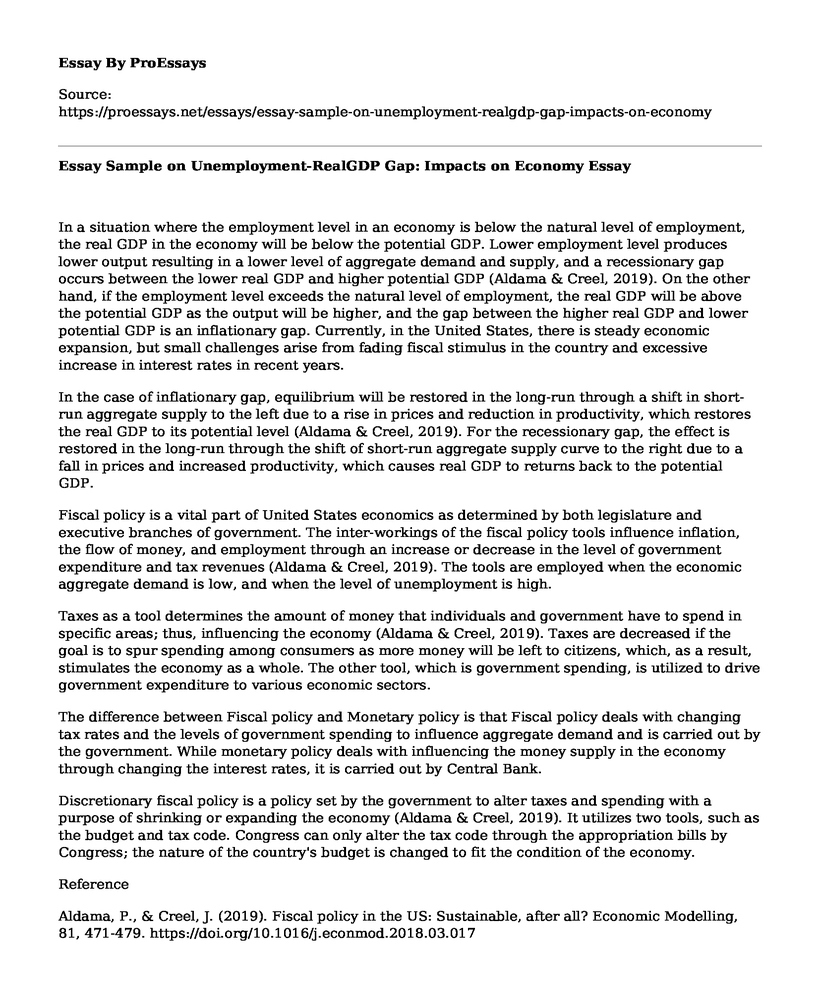In a situation where the employment level in an economy is below the natural level of employment, the real GDP in the economy will be below the potential GDP. Lower employment level produces lower output resulting in a lower level of aggregate demand and supply, and a recessionary gap occurs between the lower real GDP and higher potential GDP (Aldama & Creel, 2019). On the other hand, if the employment level exceeds the natural level of employment, the real GDP will be above the potential GDP as the output will be higher, and the gap between the higher real GDP and lower potential GDP is an inflationary gap. Currently, in the United States, there is steady economic expansion, but small challenges arise from fading fiscal stimulus in the country and excessive increase in interest rates in recent years.
In the case of inflationary gap, equilibrium will be restored in the long-run through a shift in short-run aggregate supply to the left due to a rise in prices and reduction in productivity, which restores the real GDP to its potential level (Aldama & Creel, 2019). For the recessionary gap, the effect is restored in the long-run through the shift of short-run aggregate supply curve to the right due to a fall in prices and increased productivity, which causes real GDP to returns back to the potential GDP.
Fiscal policy is a vital part of United States economics as determined by both legislature and executive branches of government. The inter-workings of the fiscal policy tools influence inflation, the flow of money, and employment through an increase or decrease in the level of government expenditure and tax revenues (Aldama & Creel, 2019). The tools are employed when the economic aggregate demand is low, and when the level of unemployment is high.
Taxes as a tool determines the amount of money that individuals and government have to spend in specific areas; thus, influencing the economy (Aldama & Creel, 2019). Taxes are decreased if the goal is to spur spending among consumers as more money will be left to citizens, which, as a result, stimulates the economy as a whole. The other tool, which is government spending, is utilized to drive government expenditure to various economic sectors.
The difference between Fiscal policy and Monetary policy is that Fiscal policy deals with changing tax rates and the levels of government spending to influence aggregate demand and is carried out by the government. While monetary policy deals with influencing the money supply in the economy through changing the interest rates, it is carried out by Central Bank.
Discretionary fiscal policy is a policy set by the government to alter taxes and spending with a purpose of shrinking or expanding the economy (Aldama & Creel, 2019). It utilizes two tools, such as the budget and tax code. Congress can only alter the tax code through the appropriation bills by Congress; the nature of the country's budget is changed to fit the condition of the economy.
Reference
Aldama, P., & Creel, J. (2019). Fiscal policy in the US: Sustainable, after all? Economic Modelling, 81, 471-479. https://doi.org/10.1016/j.econmod.2018.03.017
Cite this page
Essay Sample on Unemployment-RealGDP Gap: Impacts on Economy. (2023, Apr 10). Retrieved from https://proessays.net/essays/essay-sample-on-unemployment-realgdp-gap-impacts-on-economy
If you are the original author of this essay and no longer wish to have it published on the ProEssays website, please click below to request its removal:
- The Microeconomics of Terrorism - Essay Example
- Movement in the Exchange Rate Between the Chinese Yuan and the US Dollar
- Research Paper on Gender Differences in Employment
- International Business and Walmart Paper Example
- Advantage and Disadvantage of Globalization Essay Example
- Research Paper on Supply and Demand in Public Health
- Globalization & Talent Retention: Challenges in Education - Essay Sample







